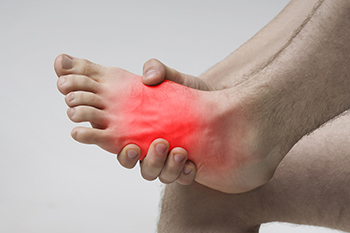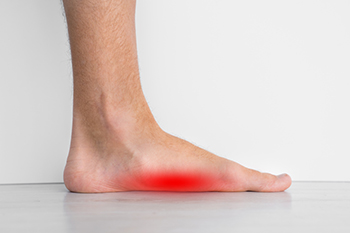July 2022
Gout Attacks Are Painful

Gout is a form of arthritis and it can create debilitating pain. It affects the joints in the big toe and it is caused by excess uric acid in the blood. This converts to crystals and lodges in the toe joints. There are specific foods that have high levels of purines in them that can lead to gout, consisting of red meat, shellfish, alcohol, and drinks that are made with large levels of sugar. The pain can last for several minutes or hours and is referred to as gout attacks. To obtain a proper diagnosis, a podiatrist may take a sample of the fluid in the joints to determine how to manage long-term gout. There are effective prevention techniques that may eliminate painful gout attacks. These include eating healthy foods daily, reducing alcohol intake, and incorporating a gentle exercise routine. If you would like additional information about how to manage gout and methods that may prevent it, please consult with a podiatrist.
Gout is a painful condition that can be treated. If you are seeking treatment, contact Dr. Mark Spier from Maryland. Our doctor will treat your foot and ankle needs.
What Is Gout?
Gout is a form of arthritis that is characterized by sudden, severe attacks of pain, redness, and tenderness in the joints. The condition usually affects the joint at the base of the big toe. A gout attack can occur at any random time, such as the middle of the night while you are asleep.
Symptoms
- Intense Joint Pain - Usually around the large joint of your big toe, and it most severe within the first four to twelve hours
- Lingering Discomfort - Joint discomfort may last from a few days to a few weeks
- Inflammation and Redness -Affected joints may become swollen, tender, warm and red
- Limited Range of Motion - May experience a decrease in joint mobility
Risk Factors
- Genetics - If family members have gout, you’re more likely to have it
- Medications - Diuretic medications can raise uric acid levels
- Gender/Age - Gout is more common in men until the age of 60. It is believed that estrogen protects women until that point
- Diet - Eating red meat and shellfish increases your risk
- Alcohol - Having more than two alcoholic drinks per day increases your risk
- Obesity - Obese people are at a higher risk for gout
Prior to visiting your podiatrist to receive treatment for gout, there are a few things you should do beforehand. If you have gout you should write down your symptoms--including when they started and how often you experience them, important medical information you may have, and any questions you may have. Writing down these three things will help your podiatrist in assessing your specific situation so that he or she may provide the best route of treatment for you.
If you have any questions, please feel free to contact one of our offices located in Columbia and Reisterstown, MD . We offer the newest diagnostic and treatment technologies for all your foot care needs.
Causes of Foot Stress Fractures

Stress fractures in the foot are usually the result of overuse or repetitive activities. They are common among runners, basketball and soccer players, and dancers. Women who are experiencing osteoporosis are also at risk. Foot stress fractures affect three main areas: the 2nd and 3rd metatarsals, the navicular bone at the top of the foot, and the calcaneus bone in the heel. Stress fractures may be difficult to detect because they are tiny hairline cracks in the bones and may easily be missed in an X-ray. Because they usually develop over time and are not immediately painful, stress fractures often go undetected or are mistaken for plain old sore feet. These fractures are caused by any activity that puts too much stress on the bones. Among the causes are increasing the frequency or length of an activity too quickly, changing from a soft to hard surface, using a faulty technique that may be the result of other conditions, and utilizing improper footwear. Even non-athletes experience stress fractures when walking too far or for too long while on vacation. If constant foot pain causes you to believe you may have developed stress fractures of the foot, please visit a podiatrist for a complete exam and diagnosis.
Stress fractures occur when there is a tiny crack within a bone. To learn more, contact Dr. Mark Spier from Maryland. Our doctor can provide the care you need to keep you pain free and on your feet.
How Are They Caused?
Stress fractures are the result of repetitive force being placed on the bone. Since the lower leg and feet often carry most of the body’s weight, stress fractures are likely to occur in these areas. If you rush into a new exercise, you are more likely to develop a stress fracture since you are starting too much, too soon. Pain resulting from stress fractures may go unnoticed at first, however it may start to worsen over time.
Risk Factors
- Gender – They are more commonly found in women compared to men.
- Foot Problems – People with unusual arches in their feet are more likely to develop stress fractures.
- Certain Sports – Dancers, gymnasts, tennis players, runners, and basketball players are more likely to develop stress fractures.
- Lack of Nutrients – A lack of vitamin D and calcium may weaken the bones and make you more prone to stress fractures
- Weak Bones – Osteoporosis can weaken the bones therefore resulting in stress fractures
Stress fractures do not always heal properly, so it is important that you seek help from a podiatrist if you suspect you may have one. Ignoring your stress fracture may cause it to worsen, and you may develop chronic pain as well as additional fractures.
If you have any questions, please feel free to contact one of our offices located in Columbia and Reisterstown, MD . We offer the newest diagnostic and treatment technologies for all your foot care needs.
Who Is Affected by Morton’s Neuroma?

Just about anyone can develop Morton’s Neuroma, a foot ailment that can be particularly painful and troublesome. However, some individuals may be at an increased risk of developing this condition, so it is important to discern your own level of risk. Morton’s neuroma primarily affects plantar digital nerves that run between the metatarsal bones of the foot. In most cases, Morton’s neuroma targets the nerve between the third and fourth metatarsal bones, resulting in pain. Although the exact cause of Morton’s neuroma is somewhat elusive and largely case-dependent, it is most likely caused by either extended straining and compression of the plantar digital nerves or inflamed joints surrounding these nerves. Certain individuals can be more susceptible to Morton’s neuroma than others. For example, approximately 75% of those who suffer from this condition are women. This is most likely due to the fact that women wear shoes such as high heels that compress the toes, putting the plantar digital nerves at risk. Additionally, ballet dancers who wear similarly restrictive footwear are at an increased risk of developing Morton’s neuroma. Individuals between the ages of 40 and 50 are typically at the highest risk of developing this condition. If you believe you may have Morton’s neuroma or are in one of these high risk categories, you might consider contacting a podiatrist.
Morton’s neuroma is a very uncomfortable condition to live with. If you think you have Morton’s neuroma, contact Dr. Mark Spier of Maryland. Our doctor will attend to all of your foot care needs and answer any of your related questions.
Morton’s Neuroma
Morton's neuroma is a painful foot condition that commonly affects the areas between the second and third or third and fourth toe, although other areas of the foot are also susceptible. Morton’s neuroma is caused by an inflamed nerve in the foot that is being squeezed and aggravated by surrounding bones.
What Increases the Chances of Having Morton’s Neuroma?
- Ill-fitting high heels or shoes that add pressure to the toe or foot
- Jogging, running or any sport that involves constant impact to the foot
- Flat feet, bunions, and any other foot deformities
Morton’s neuroma is a very treatable condition. Orthotics and shoe inserts can often be used to alleviate the pain on the forefront of the feet. In more severe cases, corticosteroids can also be prescribed. In order to figure out the best treatment for your neuroma, it’s recommended to seek the care of a podiatrist who can diagnose your condition and provide different treatment options.
If you have any questions, please feel free to contact one of our offices located in Columbia and Reisterstown, MD . We offer the newest diagnostic and treatment technologies for all your foot care needs.
Plantar Warts Can Be Treated!
Flat Feet and the Military

There are millions of people worldwide that are affected by flat feet. They can be a disqualifying condition for people who are interested in joining the military if the symptoms of flat feet are noticeable and present. Some symptoms can include pain in the arch or heel, and the ankles being swollen. Most babies are born with flat feet and the arch typically develops during the teenage years. People who never develop an arch may have no symptoms, or in the opposite case, symptoms may be obvious. These can consist of tiring easily, limited range of foot movement, and there may be a pain in the feet after walking or running. An effective method to determine if you have flat feet involves standing on your tiptoes and looking for an arch in the foot. Doing so may indicate a low arch or the arch may be nonexistent. Some patients perform foot exercises that help flat feet from being achy. If you would like to learn more about exercises and treatments for flat feet, please consult with a podiatrist.
Flatfoot is a condition many people suffer from. If you have flat feet, contact Dr. Mark Spier from Maryland. Our doctor will treat your foot and ankle needs.
What Are Flat Feet?
Flatfoot is a condition in which the arch of the foot is depressed and the sole of the foot is almost completely in contact with the ground. About 20-30% of the population generally has flat feet because their arches never formed during growth.
Conditions & Problems:
Having flat feet makes it difficult to run or walk because of the stress placed on the ankles.
Alignment – The general alignment of your legs can be disrupted, because the ankles move inward which can cause major discomfort.
Knees – If you have complications with your knees, flat feet can be a contributor to arthritis in that area.
Symptoms
- Pain around the heel or arch area
- Trouble standing on the tip toe
- Swelling around the inside of the ankle
- Flat look to one or both feet
- Having your shoes feel uneven when worn
Treatment
If you are experiencing pain and stress on the foot you may weaken the posterior tibial tendon, which runs around the inside of the ankle.
If you have any questions please feel free to contact one of our offices located in Columbia and Reisterstown, MD . We offer the newest diagnostic and treatment technologies for all your foot and ankle needs.










